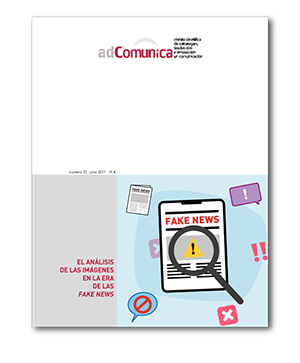La verdad es hija de la imagen: reflexiones sobre la posverdad en los tiempos del giro visual
##plugins.themes.bootstrap3.article.main##
Resum
El objetivo del presente artículo es contextualizar la problemática sobre la posverdad y las imágenes en el contexto cultural del giro visual. Para ello se analiza la historia de las imágenes técnicas, desde la fotografía y su continuidad en la postfotografía, con la intención de subrayar la construcción cultural que está detrás de la asociación entre verdad, prueba y evidencia con relación a las imágenes. El artículo cuestiona la materialidad de la imagen, ya sea analógica o digital, como garante de su verdad o mentira y se cuestiona por las prácticas visuales que están detrás de esas asunciones. El artículo también analiza temas teóricos y sociológicos que son fundamentales para entender el contexto de la posverdad y las imágenes, como el giro visual, el capitalismo de ficción o las cultural virtuales. Finalmente, el artículo estudia el papel de las imágenes en el contexto geopolítico de las plataformas de la Web 2.0.
Descàrregues
##plugins.themes.bootstrap3.article.details##
1. Política propuesta para Revistas que ofrecen Acceso Abierto
Los autores que publican en esta revista están de acuerdo con los siguientes términos:
- Los autores conservan los derechos de autor y garantizan a la revista el derecho de ser la primera publicación del trabajo al igual que licenciado bajo la licencia CC BY-SA, que permite a otros compartir el trabajo con un reconocimiento de la autoría del trabajo y la publicación inicial en esta revista.
- Los autores pueden establecer por separado acuerdos adicionales para la distribución no exclusiva de la versión de la obra publicada en la revista (por ejemplo, situarlo en un repositorio institucional o publicarlo en un libro), con un reconocimiento de su publicación inicial en esta revista.
Referències
Barthes, Roland (1968). El susurro del lenguaje. Barcelona: Paidós.
Barthes, Roland (1989). La cámara lucida. Nota sobre la fotografía. Barcelona: Paidós.
Batchen, Geoffrey (2004). Arder en deseos. La concepción de la fotografía. Barcelona: Gustavo Gili.
Baudrillard, Jean (1984). Cultura y simulacro. Barcelona: Kairós.
Bazin, André (1990). ¿Qué es el cine? Madrid: Rialp.
Benjamin, Walter (2007). Obras. Madrid: Abada.
Boehm, Gottfried (1994). Was ist ein Bild? München: Fink.
Boehm, Gottfried (2011). ¿Más allá del lenguaje? Apuntes sobre una lógica de las imágenes. En: García Varas, Ana (ed.). Filosofía de la imagen. Salamanca: Universidad de Salamanca.
Crary, Jonathan (2007). Las técnicas del observador. Visión y modernidad en el siglo XIX. Murcia: Cendeac.
Daston, Lorraine y Gallison, Peter (2007), Objectivity. New York: Zone Books.
Debord, Guy (1999). La sociedad del espectáculo. Valencia: Pre-Textos.
Denson, Shane (2020). Discorrelated images. Durham: Duke University Press.
Didi-Huberman, Georges (2013). Cómo abrir los ojos. En: Farocki, Harun. Desconfiar de las imágenes. Buenos Aires: Caja Negra.
Dubois, Philipe (1996). El acto fotográfico: de la representación a la percepción. Barcelona: Paidós.
Flusser, Villem (2001). Una filosofía de la fotografía. Madrid: Síntesis.
Fontcuberta, Joan (2011). La cámara de Pandora. La fotografi@ después de la fotografía. Barcelona: Gustavo Gili.
Fontcuberta, Joan (2015). El beso de Judas. Fotografía y verdad. Barcelona: Gustavo Gil.
Fontcuberta, Joan (2016). Desfosilizar la verdad. En: Marzo, Jorge Luis (2016). Fake. No es verdad, no es mentira. Valencia: IVAM.
García Varas, Ana (2011). Lógica(s) de la imagen. En: García Varas, Ana (ed.). Filosofía de la imagen. Salamanca: Universidad de Salamanca.
Gelfert, Axel (2018). Fake news: a definition. En: Informal logic, vol.38, nº1. Windsor: University of Windsor: 84-117.


